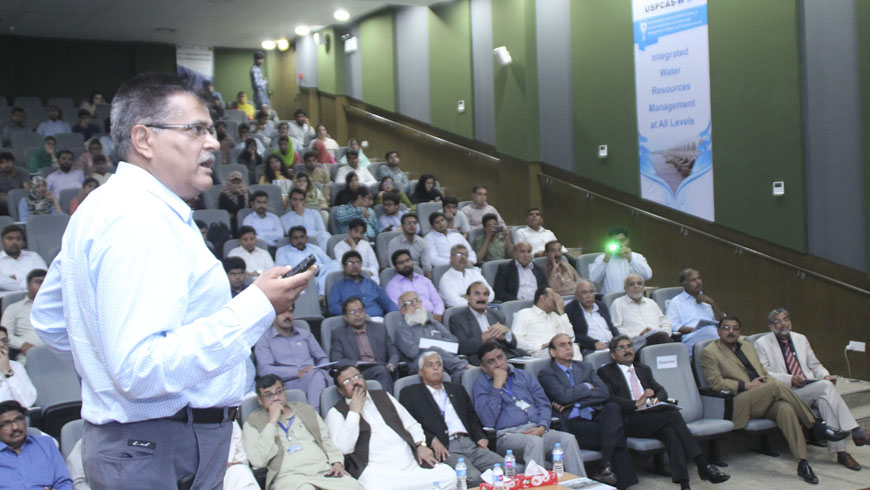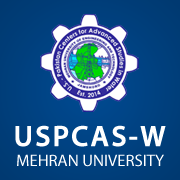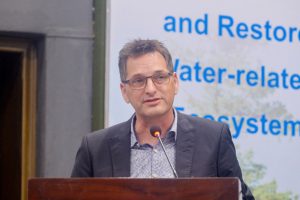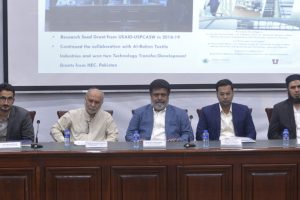
National Seminar on Shrinking Indus Delta: Current Status and Way Forward held at USPCAS-W MUET
Dr. Mohammad Aslam Uqaili, Vice Chancellor Mehran University of Engineering and Technology (MUET) said that availability of fresh wateris the global issue, which is declining day by day. He said while speaking in the National Seminar on Shrinking Indus Delta: Current Status and Way Forward held at U.S.-Pakistan Center for Advanced Studies in Water (USPCAS-W) MUET Jamshoro. Dr. Uqaili said that the communities living in the lower riparian of the rivers have right for a due share of water recognized everywhere in the world. He said that Indus River known as Sindhu is because most of the rivers are known by the area of lower riparian. Dr. Uqaili said that due to lack and sometimes zero fellow in the sea cause sea intrusion which ultimately affects the livelihood of the communities of the respective area. He stressed to ensure the flow of water Indus Delta to save the climate and ecosystem and the people associated with.
In seminar ’s technical session Prof. Dr. Altaf Ali Siyal, the principal investigator of this fifteen-month study while sharing his findings said that Indus Delta is fifth largest and one of the most vulnerable deltas of the world, designed as Ramsar wetland and supports 7th largest mangrove forest system in the world. While sharing the presentations slides, Dr. Siyal said geo morphological, environmental and socio-economic characteristics of the Indus River Delta are under constant threat due to coastal erosion and resulting dynamics in the shoreline position. He said that the left side of the river Indus of Sujawal District is more degraded and more vulnerable to coastal erosion as compared to the right side of the river the Thatta District. He said that rapid sea intrusion had degraded the Indus Delta which affected the community very badly and only 4% is drinkable water is accessible by the communities of the Delta. While distinguishing the various in the existing data, Dr. Siyal said that the net inward shift of water in the shoreline /coastline is quantified as 860±90 m using DSAS software while it is 1295m±260 through manual calculations.
He said that the higher shoreline /coastline change rate was observed 34.3 m/year for the period 1990-2017 compared to 28.4 m/year in 1972-1990. He said that now the delta existed only on 1070 square kilometer where it was 12900 square kilometer in 1838 A.D. He observed in his study that tidal floodplain area has increased from 0.6 to 0.64 million hectares (Mha) about 7.1% increase, whereas the subsurface seawater intrusion is quantified as 1.15 Mha (88.3% of Delta) while only 0.15 Mha (11.7%) is still unaffected. He said that the 80% flow Indus river flow to thedeltais decreased from 1935 to 2017 and resultantly 80% of the entire delta have salt-affected soils. He said water bodies in the entire delta have doubled in last 27 years and 80% of the natural surface water bodies (lakes) had saline water unfit for drinking purpose. He warned that if due to Tsunami or other natural reason seawater level rises about 5 m, more than 50% of Delta will be flooded. While sharing recommendations of the research study, Dr. Siyal suggested a protective levee of about 200 km length and 2 to 4-meter height should be constructed along the periphery of the tidal floodplains on an emergency basis.
He recommended that relic river channels, such as Ochito and Old Pinyari should be restored and revived, which will carry extra flood water during peak flood to the sea and also will supply fresh water to coastal communities living far from the main river course, recharge groundwater and thus will be supportive in revitalizing the delta. He advised that for minimizing the surface and subsurface seawater intrusion in the entire delta, irrigation water flow at the tail end of irrigation canals off-taking from Kotri Barrage especially Pinyari, Phuleli and KB Feeder should be assured. He opined that the most of the Natural lakes in the delta are saline, which should be revived by adding fresh water during the monsoon period because the freshwater lakes not only provide drinking water to communities but also work as groundwater recharge spots. He further recommended that the cultivation of value-added halophytes such as Salicornia, Sea Aster, Spartina Alterniflora, Suaeda, etc. in the tidal flood plains should be introduced and encouraged by the Government. It will provide fodder and livelihood to coastal communities.
On this occasion, Prof. Dr. Bakshal Khan Lashari, the project director USPCAS-W MUET said that Center was established with the generous support from American People through United States Agency for International Development (USAID) three years ago. He said that with technical support of University of Utah, USA, the MUET Water Center striving hard for the sustainable solutions of water-related issues of the country. He informed that 100 water applied research projects have been carried forward by the USPCAS-W.
Atthe end of the seminar, Prof. Dr. RasoolBux Mahar, the Deputy Director presented the vote of thanks while Prof. Dr. Kamran Ansari moderated the question-answer session.
Prof. Dr. Tauha Hussain Ali, Pro Vice Chancellor MUET, Dr. Sarfraz Hussain Solangi Pro-Vice Chancellor of Sindh University Thatta Campus, Additional Secretary Livestock and Fisheries Khawar Parvez Awan, MUET Deans Dr. Khan Muhammad Brohi, Dr. Abdul Sami Qureshi, Prof. Dr. Muhammad Moazam Baloch, Dr. Muhammad Moazm Baloch, SAFWCO Chief Suleman G. Abro SAFWCO, MDC Executive Director Dr. Yameen Memon, RDF Chief Executive Ashfaq Soomro, Director Pakistan Meteorological Department Abdul Qayoom Bhutto, Prof. Dr. Mohammad Ismail Kumbhar, Prof. Dr. Najma Memon, civil society activist from Thatta Akhtar Samo and communities from the Indus Delta, faculty and students of the Center were among participants of the seminar.




